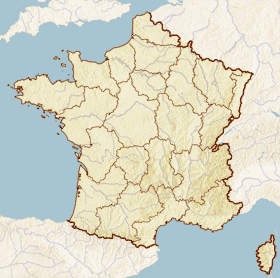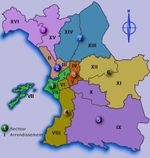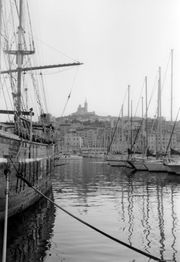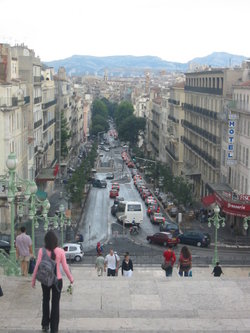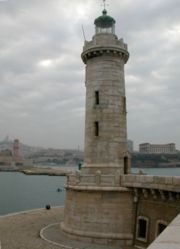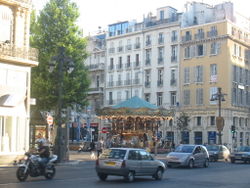Marseille
2007 Schools Wikipedia Selection. Related subjects: European Geography
| Ville de Marseille | ||
|
 |
|
| City flag | Coat of arms | |
| Motto: Actibus immensis urbs fulget Massiliensis. "By her great deeds, Marseille shines in the world" |
||
| Location | ||
|
||
| Coordinates | ||
| Time Zone | CET (GMT +1) | |
| Administration | ||
|---|---|---|
| Country | France | |
| Région | Provence-Alpes-Côte d'Azur | |
| Département | Bouches-du-Rhône (13) | |
| Subdivisions | 16 arrondissements (in 8 secteurs) |
|
| Intercommunality | Urban Community of Marseille Provence Métropole | |
| Mayor | Jean-Claude Gaudin ( UMP) (since 1995) |
|
| City Statistics | ||
| Land area¹ | 240.62 km² | |
| Population² | 2nd in France | |
| - 2004 estimate | 808,700 | |
| - Density | 3,361/km² (2004) | |
| Urban Spread | ||
| Urban Area | 1,290 km² (1999) | |
| - Population | 1,349,772 (1999) | |
| Metro Area | 2,830.2 km² (1999) | |
| - Population | 1,516,340 (1999) | |
| Miscellaneous | ||
| Postal code | 13001-13016 | |
| Dialling code | 0491 | |
| ¹ French Land Register data, which excludes lakes, ponds, glaciers > 1 km² (0.386 sq. mi. or 247 acres) and river estuaries. | ||
| ² Population sans doubles comptes: single count of residents of multiple communes (e.g. students and military personnel). | ||
- "Marseilles" redirects here. There is also Marseilles, Illinois.
- "Massilia" redirects here. There is also a ship with this name; see The Vichy 80.
Marseille, (English alt. Marseilles — French: pronounced /maʀsɛj/ or [mɑxˈsɛjɐ] locally — Provençal Occitan: Marselha [maʀˈsejɔ, maʀˈsijɔ] in classical norm or Marsiho [maʀˈsijɔ] in Mistralian norm — Latin: Massilia) is the second largest city in France and the third metropolitan area, with 1,516,340 inhabitants at the 1999 census. Located in the former province of Provence and on the Mediterranean Sea, it is France's largest commercial port. It is considered the Provençale capital, one of the Occitan capitals of Occitania and France. Marseille is also the capital of the Provence-Alpes-Côte d'Azur région, as well as the préfecture (capital) of the Bouches-du-Rhône département.
Geography
Marseille is the centre of a large metropolitan area. To the east are the villages of the Calanques and Cassis, further afield is the town of Toulon. To the north of Marseille are a range of small mountains and the 1011m Mont Saint Victoire. To the west of Marseille is the Camargue region and the Gulf of Lion. The city itself is spread across a wide geographical area divided into 15 arrondissements. The central four contain most of the city's historic buildings and its services.
The city's main thoroughfare, the wide boulevard called La Canebière, stretches eastward from the Old Port (Vieux Port/Panier quarter). The tourist information centre operates at the Old Port end of the Canebière. Adjacent to La Canebière is the Old Port (where the marina and fish market are located.) At the entrance to the Old Port are two large forts - Fort St Nicholas on the south side and Fort St Jean on the other. The main commercial centre of the city intersects with the Canebière at Rue Paradis and the Centre Bourse (the main shopping mall). Pedestrianised squares radiate away from the Canebière and the old port such as Cours Julien and the Place de General De Gaulle, both of which have fountains.
To the south east of central Marseille is the Prefecture and the roundabout Castellane (a bus and metro interchange) in the 7th arrondissement. To the south west are the hills of the 9th arrondissement, dominated by the Notre-Dame-de-la-Garde. The train station - Gare St Charles - is north of the Centre Bourse in the 3rd arrondissement. It is at the end of La Canebière and is near the square of Victor Hugo. The airport Marseille-en-Provence lies to the North West of the city at the Etang de Berre.
History
Marseille was founded in 600 BC by Greeks from Phocaea as a trading port under the name Μασσαλία (Massalia; see also List of traditional Greek place names). Massalia was the first Greek port in Western Europe and grew to a population of over 1000 and the first settlement given city status in France. Facing an opposing alliance of the Etruscans, Carthage and the Celts, the Greek colony allied itself with the expanding Roman Republic for protection. The association with the expanding Roman market saw the city thrive by acting as a link between the interior of Gaul, hungry for Roman goods and wine (of which Massilia was steadily exporting by 500 B.C.) , and Rome's insatiable slave markets. Under this arrangement the city maintained its independence until the rise of Julius Caesar, when it joined the losing side (Pompey) in civil war, and lost its independence in 49 BC.
It was the site of a siege and naval battle in which the fleet was confiscated by the Roman authorities During the Roman times the city was called Massilia. It was the home port of Pytheas. Most of the archaeological remnants of the original Greek settlement were replaced by later Roman additions.
Marseille thrived as a Roman trading port. Evidence of its growth and wealth is the fact that it was the first town of France to have an official public sewer system. During the Roman era, the city was controlled by a directory of 15 selected “first” among 600 senators. Three of them had the preeminence and the essence of the executive power. The city's laws amongst other things forbade the drinking of wine by women and allowed by vote of the 600, assistance to allow a person to commit suicide.
With the decline of the Roman empire the town reverted to the hands of the Gauls, eventually joining much of France under the rule of the Franks. Emperor Charlemagne and the Carolingian dynasty granted civic power to Marseille, which remained a major French trading port until the medieval period. The city regained much of its wealth and trading power when it was revived in the 10th century by the counts of Provence. In 1347 the city suffered terribly from the great plague - estimates say 50,000 of the city's 90,000 inhabitants were killed. As a major port, it is believed the settlement was one of the first and most dramatically affected French settlements by the plague. The city's fortunes declined further when it was sacked and pillaged by the Aragonese in 1423.
Marseille soon revived its population and trading status in the Mediterranean and in 1437, the Count of Provence Rene of Anjou, who succeeded his father Louis II of Anjou, as King of Sicily and Duke of Anjou, arrived in Marseille and established it as France's most fortified settlement outside of Paris. He helped raise the status of the town to a city and allowed certain privileges to be granted to it. Marseille was then used by Duke of Anjou as a strategic maritime base to reconquer his kingdom of Sicily.
King René, who wished to equip the entrance of the port with a solid defence, decided to build on the ruins of the old Maubert tower and to establish a series of ramparts guarding the harbour. Jean Pardo, engineer, conceived the plans and Jehan Robert, mason of Tarascon, carried out the work. The construction of the new city defences took place between 1447 and 1453. The trading in Marseille also flourished in this term as the Guild began to establish a position of power within the merchants of the city. Notably René also founded the Corporation of Fisherman.
Marseille became a part of France in the 1480s but soon acquired a reputation for rebelling against the central government. The local population enthusiastically embraced the Revolution, and sent 500 volunteers to defend Paris in 1792 who sung what is now France's national anthem La Marseillaise. During the eighteenth century the Ports defences were improved and Marseille became more important as France's leading military port in the Mediterranean. Jean-Baptiste Grosson, royal notary, who wrote from 1770 to 1791 the historical Almanac of Marseille published in 1773 a "Recueil des antiquités et des monuments marseillais qui peuvent intéresser l’histoire et les arts", (“Collection of antiquities and Marseilles monuments which can interest history and the arts”), which for a long time was the primary resource on the history of the monuments of the city.
During the nineteenth century the city was the site of industrial innovations and manufacturing growth. The rise of the French Empire and the conquests of France since 1830 (especially Algeria) stimulated the maritime trade and raised the prosperity of the city. This can be still seen today in both the old port and the train station, where massive monuments record the conquest of North Africa and Indochina by the French, culminating in a massive arch. Maritime opportunities also increased with the opening of a vast canal in 1869.
During the twentieth century Marseilles celebrated its trading status and 'port of the empire' status through the colonial exhibitions of 1906 and 1922. In 1934 Alexander I of Yugoslavia arrived at the port to meet with the French foreign minister Louis Barthou. He was assassinated there by Vlada Georgieff. During World War II Marseille was bombed by the Germans and the Italians in 1940. The city was occupied by Germans and over one third of the old quarter of the city was destroyed in a massive clearance project, aimed to reduce opportunities for resistance members to hide and operate in the densely populated old buildings. After the war much of the city was rebuilt during the 1950s.
Modern
During the late twentieth century, the city served as an entrance port for millions of immigrants in France, hundreds of thousands of whom came in 1962 from Algeria. Many immigrants stayed and have given the city a vibrant African quarter with a large market/bazaar.
After the oil crisis of 1973 and an economic downturn, Marseille became a haven for crime and high levels of poverty. In recent decades things have improved dramatically. Through plans from the AT in Paris and funds from the EU, the city has developed a modern and advanced economy based on high technology manufacturing, oil refining and service sector employment. In terms of recent social history, Marseille has served as the home of the new right and the National Front. Because of high levels of unemployment and a large immigrant population, Marseille is home to a large population of National Front supporters.
Politically, from 1950 to the mid 1980s, Marseille was dominated by its long-term, six-times-re-elected mayor Gaston Defferre. The three most recent mayors are listed below:
- 1953-1986: Gaston Defferre PS (already mayor of 1944 to 1946, re-elected in 1959, 1965, 1971, 1977, 1983)
- 1986-1995: Robert Vigouroux RDSE (re-elected in 1989)
- 1995 -: Jean-Claude Gaudin UMP (re-elected in 2001 and 2004)
Economy
Historically the economy of Marseille was dominated by its role as a port of the French Empire, linking the North African colonies of Algeria, Morocco and Tunisia with the French mainland. The majority of the old port and docks, which experienced decline in the 1970s after the oil crisis have been recently redeveloped with funds from the European Union. The old port now contains restaurants, offices, bars and hotels. Fishing however still remains important in Marseille and the food economy of Marseille is dominated by the local catch with the daily fish market still on the Belgian Quay in the Old Port.
Even today the economy of Marseille is dominated by the port, which functions as commercial container port as well as a transport port for the Mediterranean sea. However all of Marseille's port activities now take place along the coast at the New Port (the Old port is too small for modern large ships to enter). The most important port on the Mediterranean, it handles millions of tons of freight annually. Major imports include petroleum, wine, fruits, olive oil, hides and skins, and tropical agricultural products. Major exports are dominated by wines, liqueurs, processed foods, cement, and metal products. Petroleum refining and shipbuilding are the principal industries, but chemicals, soap, glass, sugar, building materials, plastics, textiles, olive oil, and processed foods are also important products. Marseille is connected with the Rhône via a canal and thus has access to the extensive waterway network of France. Petroleum is shipped northward to the Paris basin by pipeline. The city also serves as France's leading centre of oil refinement.
Marseille is a major French centre for trade and industry, with an excellent transportation infrastructure (roads, sea port and airport). The airport, Marseille-Provence, is the leading French airport outside Paris. It is the main arrival base for millions of tourists each year as well as serving a growing business community. The area around the airport and near the borders of Aix-en-Provence and northern Marseille now boasts a successful business and science park. Marseille is also home to the University of Provence. The economy is closely associated with the Marseille Provence Metropolis, France's second largest research centre with 3000 research scientists. Marseille Metropole Provence is home to thousands of companies, 90% of which are small businesses. Among the most famous ones are: CMA-CGM, container-shipping giant; Comex, world leader in sub-sea engineering and hydraulic systems; Eurocopter Group, an EADS company; Azur Promotel, an active real estate development company; La Provence, the local daily newspaper; L' Olympique de Marseille, the famous soccer club; RTM, Marseille's public transport company; and Société Nationale Maritime Corse Méditerranée (SNCM), a major operator in passenger, vehicle and feright transportation in the Western Mediterranean.
In recent years the city has also experienced a large growth in service sector employment and a switch from light manufacturing to a cultural economy. Marseille acts as a regional nexus for entertainment in the south of France and has a high concentration of museums, cinemas, theatres, clubs, bars, restaurants, fashion shops, hotels and art galleries, all geared towards a tourist economy.
Unemployment in the economy has fallen to 13 percent in 2005 from 20 percent in 1995. In May, the French financial magazine L'Expansion named Marseille the most dynamic of France's large cities, citing figures showing that 7,200 companies had been created in the city since 2000. However Marseille remains a city with high unemployment against the European average and suffers a lack of jobs for its large immigrant population. Whilst much of the Marseille economy has been revitalised since its decay in the 1970s it still remains significantly stagnant in regards to growth compared with Paris and the old industrial regions of north-eastern France.
Administration
Marseille is divided into 16 municipal arrondissements, which are themselves divided into quartiers (111 in total). The arrondissements are regrouped, in pairs, into 8 sectors, with each sectors having a council and a town hall (like the arrondissements in Paris and in Lyon).
The municipal elections are carried out by sector. Each sector elects its councillors (303 in total), one third of which are municipal councillors.
Number of councilors elected by sector:
| Sector | 1 | 2 | 3 | 4 | 5 | 6 | 7 | 8 | Total |
|---|---|---|---|---|---|---|---|---|---|
| Sector councilors | 22 | 16 | 22 | 30 | 30 | 26 | 32 | 24 | 202 |
| Municipal councilors | 11 | 8 | 12 | 13 | 15 | 13 | 16 | 12 | 100 |
| Total number of elected officials | 33 | 24 | 33 | 42 | 45 | 39 | 48 | 36 | 303 |
The Sector Mayors :
- 1st sector (1st and 7th arrondissements): Jean Roatta (Representative) UMP
- 2nd sector (2nd and 3rd arrondissements): Lisette Narducci (General Councilor) PS
- 3rd sector (4th and 5th arrondissements): Bruno Gilles (representative) UMP
- 4th sector (6th and 8th arrondissements): Dominique Tian (representative) UMP
- 5th sector (9th and 10th arrondissements): Guy Teissier (representative) UMP
- 6th sector (11th and 12th arrondissements): Roland Blum (representative) UMP
- 7th sector (13th and 14th arrondissements): Garo Hovsepian PS
- 8th sector (15th and 16th arrondissements): Frédéric Dutoit (representative) PCF
The cantons of Marseille :
Marseille holds 25 of the 58 seats at the general council of the Bouches-du-Rhône. Since the last election, these 25 cantons are held by the following councilors:
- Marseille-La,Belle-de-Mai (pop. 25,878); General Councilor: Lisette Narducci PS (Mayor of the 2ème sector de Marseille)
- Marseille-Belsunce (pop. 27,992); General Councilor: Fortuné Sportiello PS
- Marseille-La,Blancarde (pop. 30,168); General Councilor Maurice Di Nocera UDF
- Marseille-Le,Camas (pop. 27,506); General Councilor: Antoine Rouzaud PS (Municipal councilor of Marseille)
- Marseille-La,Capelette (pop. 34,292); General Councilor: Janine Ecochard PS
- Marseille-Les,Cinq-Avenues (pop. 29,846); General Councilor: Marie-Arlette Carlotti PS (Representative européenne)
- Marseille-Les,Grands-Carmes (pop. 29,060); General Councilor: Jean-Noël Guerini PS (Sénateur, Président du Conseil Général, Municipal councilor of Marseille)
- Marseille-Mazargues (pop. 35,890); General Councilor: Didier Réault UMP
- Marseille-Montolivet (pop. 33,644); General Councilor: Maurice Rey UMP
- Marseille-Notre-Dame-du-Mont (pop. 31,107); General Councilor: Jocelyn Zeitoun PS
- Marseille-Notre-Dame-Limite (pop. 33,472); General Councilor: Joël Dutto PCF
- Marseille-Les,Olives (pop. 27,052); General Councilor: Marius Masse PS
- Marseille-La,Pointe-Rouge (pop. 31,116); General Councilor: Richard Miron UMP
- Marseille-La,Pomme (pop. 38,701); General Councilor: René Olmeta PS (Municipal councilor of Marseille)
- Marseille-La,Rose (pop. 33,206); General Councilor: Félix Weygand PS
- Marseille-Saint-Barthélemy (pop. 37,629); General Councilor: Denis Rossi PS (Municipal councilor of Marseille)
- Marseille-Sainte-Marguerite (pop. 36,868); General Councilor: Didier Garnier UMP
- Marseille-Saint-Giniez (pop. 34,621); General Councilor: Martine Vassal UMP (Adjointe au Maire de Marseille)
- Marseille-Saint-Just (pop. 32,749); General Councilor: Michel Pezet PS (Municipal councilor of Marseille)
- Marseille-Saint-Lambert (pop. 26,218); General Councilor: Robert Assante UMP (Adjoint au Maire de Marseille)
- Marseille-Saint-Marcel (pop. 29,981); General Councilor: Jean Bonat PS (Municipal councilor of Marseille)
- Marseille-Saint-Mauront (pop. 40,392); General Councilor: Jeanine Porte PCF
- Marseille-Les,Trois,Lucs (pop. 25,324); General Councilor: Christophe Masse PS (Representative)
- Marseille-Vauban (pop. 29,668); General Councilor: André Malrait UMP
- Marseille-Verduron (pop. 35,752). General Councilor: Henri Jibrayel PS
Demographics
The population growth of Marseille followed the national average until the mid 20th century. From the years 1200 to 1800 the population remained below 100,000. From 1800 to 1930 the population grew to over 500,000. The majority of population growth was from natural birth though a significant amount of Italian, Portuguese and Spanish immigrants arrived. By the mid-1950s, Marseille, as France's largest sea port, experienced a massive demographic growth as a result of the thousands of immigrants arriving. Later, many immigrants came from former French colonies from North Africa, notably migrants from Algeria. The population of central Marseille grew to just under one million by the 1980s. In the last three decades the population of Marseille has declined, as more and more inhabitants move elsewhere for work, or to the suburbs to avoid the inner city.
Today, many Marseillais are descendants of the waves of immigrants that arrived at the port in the early 19th century. As a result, the ethnic French are a minority. The largest ethnic group in the city are Italians, who make up 37.5% more than a third of the city's total population. Other significant populations include North African Arabs (25% of the total population), and Armenians (12.5% of the total population ). It is estimated that roughly a quarter of the population are ethnic French. Other significant immigrant groups include people of Turkish, Greek, German and Vietnamese origins. The Jewish community is also said to be the third largest in Europe (France has the largest Jewish community in Europe and the third largest in the world).
Climate
Marseille has a Mediterranean climate, with mild, dry winters and warm, humid summers. January and February are the coldest months, averaging temperatures of 10 °C (51 °F). July and August are the hottest months, averaging temperatures of 25 °C (78 °F). Marseille is known for its Mistral (wind) that occurs mostly in winter and spring.
| Month | Jan | Feb | Mar | Apr | May | Jun | Jul | Aug | Sep | Oct | Nov | Dec | Year |
|---|---|---|---|---|---|---|---|---|---|---|---|---|---|
| Avg high °C (°F) | 10 (51) | 11 (53) | 14 (58) | 17 (63) | 21 (70) | 25 (78) | 28 (84) | 28 (83) | 25 (77) | 20 (68) | 14 (58) | 11 (53) | 18 (66) |
| Avg low °C (°F) | 2 (37) | 3 (38) | 5 (42) | 8 (47) | 12 (54) | 16 (61) | 18 (66) | 18 (65) | 15 (60) | 11 (52) | 6 (44) | 3 (38) | 10 (50) |
| Source: Weatherbase | |||||||||||||
Culture
Marseille is a city that is proud of its difference from greater France. In the lead-up the French Revolution a group of Marseillais embarked from the south of France to support the conflict and dismantling of the Bastille. The French national anthem " La Marseillaise" was so named because it was first known as sung on the streets as a rallying call of the French Revolution by troops from Marseille. Today Marseille is a site of regional culture and entertainment served by its important opera house, its history and maritime museums, its five galleries and vast amount of cinemas, clubs, bars and restaurants.
In regards to literature and the arts, Marseille has been the birth place and home of many French writers. In modern times, one can quote Victor Gélu, Valère Bernard, Pierre Bertas, Edmond Rostand and André Roussin as leading examples. The artist Cézanne spent much time in Marseille and painted several works of art there. The most widely circulated tarot deck comes from Marseille; it is called the Tarot de Marseille, and was used to play the local variant of tarocchi before it became used in cartomancy.
Opera
Marseille's main cultural attraction was, since its creation at the end of the 18th century and until the late 1970s, the Opéra. Located near the Old Port and the Canebière, at the very heart of the city, its architectural style is comparable to the classical trend found on other opera houses built at that time in Lyon and Bordeaux. In 1920 a fire almost completely destroyed the building, leaving only the façade's colonnade which can still be admired today. The reconstruction led to a major competition with a main focus on the Art Deco style. For example, Bourdelle worked on the frescos which frame the drop cloth. The Opera's artistic value led the municipality to classify the building as a historical monument. The future of Marseille's Opéra stands on attracting younger groups, rejuvenating the monument's aging image, and achieving the recognition of the sought-after title of 'National Opera'. Marseille is candidate for becoming 'the European city of culture' and its opera house will play an important part.
Sister cities
Music
- The French rap band IAM are from Marseille
- Fonky Family
- Massilia Sound System
- Watcha Clan
- Paul Mauriat
- André Pascal
- Vincent Scotto
- Marius Petipa
- Jehro
Movies set in Marseille
Marseille has been the setting for films, both Hollywood and local French films.
- 37°2 le matin (1986)
- Baise-moi (2000)
- Bye-Bye (1995)
- Comme un aimant (2000)
- Gomez & Tavarès (2003)
- La Lune dans le caniveau (1983)
- Love Actually (2003)
- Marius (1931)
- Marius et Jeannette (1997)
- Roselyne et les lions (1989)
- Taxi (1998)
- Taxi 2 (2000)
- Taxi 3 (2003)
- The French Connection (1971)
- French Connection II (1975)
- Trois places pour le 26 (1988)
- Un, deux, trois, soleil (1993)
Sights
Marseilles is classified as a significant centre of art and history. The city boasts many excellent museums and galleries. Of historical interest are many ancient buildings and churches.
1st and 2nd Arrondissements
The 1st and 2nd arrondissements are the site of most of Marseilles shops and attractions, which include:
- The Old Port of Marseilles, also known as the Panier or the Vieux Port, is the main marina of the city. It is guarded by two massive forts (Fort St Nicholas and Fort Saint Jean) and is the main place for eating in the city. Dozens of cafes line the Marina. The Quay des Belges (The Belgian Quay) is the site of the daily fish market. Most of the area was rebuilt by the architect Fernand Pouillon after much of it was destroyed by the Nazis in 1940.
- The Phare de Sainte Marie - a lighthouse on the inlet to the Old Port
- La Vieille Charité in the Old Port is a grand building once used as a workhouse and charity hospice. It has an archeological museum and a gallery of African and Asian art.
- The Centre Bourse is the main shopping centre of Marseille and contains both the History Museum (below) as well as a series of open archeological ruins now used as a park.
- The Musee D'Histoire is the Marseille history museum, which contains records of the Greek and Roman history of Marseille as well as the most fully recovered hull of a 6th century boat in the world.
- The Musee de la Maritime is a small museum located in the old Chamber of Commerce, devoted to the sea economy of Marseille over the centuries. Also of note, the old Chamber of Commerce is a significant historical building - the first Chamber of Commerce in France and includes a collection of model ships.
- The Musee de la Mode is a modern fashion museum which looks at the last 30 years of design and has over 2000 items on display.
- The Musee Cantini is an art museum near the Palais De Justice - it houses artworks associated with Marseille as well as several works by Picasso.
- Pierre Puget park
Outside of Central Marseille
- The Cathedral of Notre-Dame-de-la-Garde, built by the architect Jacques Henri Esperandieu is an enormous Romano-Byzantine basilica 1KM south of the Old Port. Well worth the steep climb, views from the Cathedral extend to the suburbs of Marseille.
- The Marseilles Stadium and Velodrome, where local football matches are held along with the Olympique de Marseille
- The Gare Saint-Charles - The main train station
- Unité d'Habitation, by the Swiss architect Le Corbusier
- The Hôtel-God
- Saint-Joseph Hospital
- The Palais de Longchamp is a grand colonnaded building. It houses two of Marseille's old museums - the Musee des Beaux-Arts and the natural history museum.
- Borély park
- Chanot park
Outside Marseille
- The calanques - famous coastal features (can be visited by car or a bus from the Castellane)
- The local beaches such as Prado
- The abbey of Saint-Victor and its crypt which is the oldest place Christian worship in France
- Château d'If, an ancient prison on the island of If, where The Count of Monte Cristo was jailed, in the novel by Alexandre Dumas. The island can be reaced via boat trips form the Old Port. The islands of Ratonneu and Pomegues are also near to the Château d'If and an important centre for sea wildlife.
Transport
The city is served by an international airport, Aéroport de Marseille Provence, located in Marignane. The airport has two terminals. Terminal one, the main terminal of the aiport contains halls 1,2,3 and 4 and serves as a base for international arrivals and departures. The new terminal, refered to as Marseille Mp2 is used for flights arriving and departing from Europe. A shuttle coach system operates between the airport and the train station Saint-Charles.
The train station Saint-Charles is Marseilles leading train station, the other being the Maritime station. The centenary railway station of Saint-Charles operates regional services to nearby towns such as Toulouse and Nice as well as being the end of the TGV in the south of France. Trains take only three hours to make the huge distance to Paris.
Marseille itself is connected by the metro train system consisting of 2 lines represented by orange and blue. Line 1 (blue) between Catellane and La Rose opened in 1977 and Line 2 (orange) between Sainte-Marguerite/Dromel and Bougainville opened between 1984 and 1987. An extension to Line 1 from Castellane to La Timone was completed in 1992 and a further extension from La Timone up to La Fourragère was recently completed. The Metro system operates on a turnstile system, with tickets purchased at the nearby adjacent automated booths. Both lines of the Metro intersect at the Gare de Marseille Saint-Charles. Marseilles busiest Metro station is the Old Port - the Vieux Port, which is decorated with cobblestones and has fish tanks in the walls.
An extensive bus network serves the city and suburbs of Marseille. The majority of bus services originate from the Catellane - a large street near the Prefecture.
Sport
The city boasts a wide variety of sports facilities and caters to almost every interest. The dominant force in the sporting world of the city is the city's football club - Olympique de Marseille, UEFA Champions League winner in 1993. The club is reasonably successful but has was tainted recently in the 1990s match fixing scandal by then-owner Bernard Tapie. The clubs home - the stade Velodrome, also functions for other local sports including cycling and athletics.
Sailing is a major sport in Marseille. The winds can blow from different directions and allow interesting regattas in the warm waters of the Mediterranean. Most of the time it can be windy while the sea remains smooth enough to allow sailing. It has been considered as a possible site for 2008 Americas Cup. Marseille is also a place for other water sports such as windsurfing, sailing and powerboating.
Marseille has three golf courses to its north and north east. The city also boasts dozens of gyms and several council owned swimming pools. Running is also popular in many of Marseilles parks such as Le Pharo and Le Jardin Pierre Puget.
Births and deaths in Marseille
Marseille was the birthplace of:
- Antonin Artaud ( 1897- 1948), author
- Maurice Béjart (born 1927), ballet choreographer
- Jean-Henry Gourgaud, aka. "Dugazon" (1746-1809), actor
- Désirée Clary (1777-1860), wife of King Carl XIV Johann of Sweden, and therefore Queen Desirée or Queen Desideria of Sweden
- Adolphe Thiers (1797-1877), first president of the Third Republic
- Étienne Joseph Louis Garnier-Pages (1801-1841), politician
- Honoré Daumier (1808-1879), caricaturist and painter
- Joseph Autran (1813-1877), poet
- Charles-Joseph-Eugene de Mazenod (1782-1861), Bishop of Marseilles and Founder of the Missionary Oblates of Mary Immaculate.
- Marius Petipa (1818-1910), ballet choreographer
- Olivier Émile Ollivier (1825-1913), statesman
- Joseph Pujol, aka. " Le Pétomane" (1857-1945), entertainer
- Paul Mauriat (1925),orchestra leader, composer
- Edmond Rostand (1868-1918), poet and dramatist
- Vincent Scotto (1876-1952), guitarist, songwriter
- Fernandel (1903-1971), actor
- Éliane Browne-Bartroli (1917-1944), French Resistance, Croix de Guerre
- Louis Jourdan (born 1919), actor
- Jean Pierre Rampal (1922-2000), flûtiste
- André di Fusco (1932-2001), known as André Pascal, song writer, composer
- Jean-Claude Izzo (1945-2000), author
- Éric Cantona (born 1966), legendary Manchester United footballer
- Marc Panther (born 1970), member of the popular Japanese rock band globe
- Zinédine Zidane (born 1972), world class footballer currently retired from Real Madrid.
- Mathieu Flamini, footballer
- Mathieu Ganio, (1984) danseur étoile (ballet dancer)
- Romain Barnier (born 1976), freestyle swimmer
- Sébastien Grosjean (born 1978), tennis player
The following personalities died in Marseille:
- French poet Arthur Rimbaud on November 10, 1891.
- King Alexander I of Yugoslavia was assassinated on October 9, 1934 in Marseille along with French Foreign Minister Louis Barthou.
Gallery
|
Madonna and Child statue on the Basilique Notre-Dame de la Garde. |
Musée des Beaux Arts, Marseille. |
Joan of Arc statue in Marseille. |

